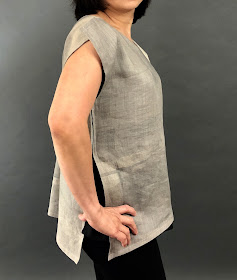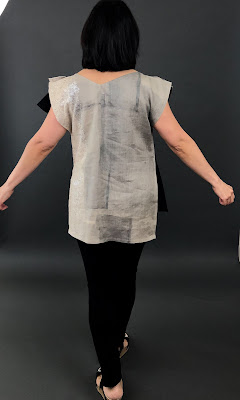I recently purchased this pattern with plans to sew the top.
It was not really love at first sight but the more I studied the pattern, the more I liked it. I thought it could work well for a sheer fabric I have in my stash. So I decided to sew a wearable muslin using some leftover linen fabrics.
About the pattern
This is the first time I have tried a Sandra Betzina design. Although it is a Vogue pattern, the sizing chart is different from the usual numerical ones from Vogue. All sizes in one envelope are designated by letters from A-J. Sandra has some helpful tips included as foreword in the pattern instruction pages so it is important to read them first. For the top she advised choosing the size based on the bust size since the top is loose fitting and the fit quite forgiving.
I was not sure which size to use because I was in between two sizes. No finished garment measurements were provided except for the back length. So to help me make a decision, I did some flat pattern measurement. The pattern pieces were more or less rectangular in shape so no real waistline to worry about. I determined the smaller size would have enough wearing ease so I cut the size A.
Fabric
For the front and back, I used some leftover linen with border print. This was a Japanese fabric from the Nani Iro line called "Wildflower" designed by Naomi Ito for Kokka. I used it before to sew a Burda top which I posted about here.
For the underlay I used a solid black linen, also from stash.
Shown here is the layout of the front and back pattern pieces.
This is the front underlay piece.
Construction Notes
The pattern instructions are easy to understand and the illustrations are clear. I have written down some additional construction tips. Hopefully, they may prove helpful to someone else attempting to sew this wonderful pattern!
Back Piece
There are only three major pieces for the top--front, back, front underlay. However, there is a small additional pattern piece that is supposed to be traced over the back pattern piece.
Although the back piece is a simple rectangular shape, it requires overlaying a separate pattern piece that contains the drawing lines for what would become the back neckline.
For accuracy, I followed a tip I read on Pattern Review. I traced the line drawing on a separate tracing paper and pinned it over the back fabric piece.
I then machine basted along the lines to transfer the neckline shape to the fabric then tore off the tissue. Later on it would be easier to sew accurately around the neckline by following the stitches.
Stabilizing the Necklines:
To prevent the V necklines, one has to sew a stay tape. I had a lot of silk organza in my stash from a previous wedding gown project so I decided to use a 3/8" strip of silk organza selvedge for the stay tape.
I pinned the stay tape, centering it over the neckline's 5/8" seamline which was marked by machine stitches.
I also sewed a small square of silk organza to the center of the V to stabilize the point where it will be clipped.
Same thing is done with the back neckline.
Finishing the Edges:
As printed on the envelope, this pattern is different because of the unusual construction. There are no typical seams like shoulder or side seams. So early on, one has to finish the edges.
Even though the default seam allowance for the big 4 patterns is 5/8", in this case, it is 1" as printed on the pattern pieces.
Hence one has to turn in the edges by 1/2" twice.
The top edge of the back piece will become the bottom edge of the facing once folded. I chose to finish it by serging.
Back Neckline:
The construction of the back neckline is very interesting. One starts with a rectangular piece of fabric.
After stabilizing the outline of the neckline, the top is folded to so that right sides of fabric are together. Then the neckline is sewn following the stitching lines. Hence, it is important to be accurate.
The excess fabric is then trimmed off leaving about 1/4" seam allowance around the neckline.
Here's a view of the back neckline after it has been understitched.
Shoulders:
The shoulders are sewn using overlapping seams. The back shoulder edge is sewn over the front underlay shoulder and then the front shoulder is sewn over the back. Because of this method of construction, accurate transfer of all markings and placement lines is very important.
1) Back shoulder edge pinned to placement line on front underlay shoulder.
 |
| View of the stitched shoulder edges. |
 |
| View of the stitching line from the wrong side of the underlay. |
2) Front shoulder over the sewn back/front underlay shoulder.
 |
| I used one of the decorative stitches on my machine to topstitch the shoulder edges together. |
 |
| View of the finished shoulders. |
Side Seams
There are no regular side seams. To close the sides, one has to match all the markings on the three layers. Here is where one can make adjustments. In my case, I raised the stitching lines and made it longer. Otherwise, there would be too much skin showing!
Finished Top
And here are photos of the finished garment. I must say I am in love with this! I can't remember having so much fun sewing a project because of the unusual construction. And the result was a pleasant surprise!















































What an unusual and lovely design Maria! Your finished top is fabulous!
ReplyDeleteThanks Diane! It was really a fun project even though there were a few times I was scratching my head wondering where it will all lead to!
DeleteI have this pattern and I have been thinking of making it up. Thanks for the insights.
ReplyDeleteYou're most welcome!
DeleteYour sewing & fabric matching is beautiful. Well done.
ReplyDeleteThanks so much!
DeleteMaria, I absolutely in awe of this! So lovely!
ReplyDeleteI like to visit your blog very much. Thanks for sharing photos. I admire your work. I am waiting for more projects
ReplyDeleteRegards, https://ctnbee.com/en/printing-on-woven-fabrics
Thank you so much!
DeleteThis is so gorgeous! I was interested in the pattern but wasn't sure about getting it till I saw yours made up. I have a tiny bit of the same fabric and might copy yours, if that's OK!
ReplyDeleteThanks so much Tracy! Of course it's okay! I'm delighted to have inspired you.
DeleteWow! I love the Japanese fabric! I just started cutting out the paper pattern and find that E in one area does not correlate with E as it goes around the corner in the neck area. It continues at H... and the pattern lines are so light, hard to see. I bought this pattern last year; maybe they made a mistake. I haven't made a challenging pattern in years...back when I had a figure (and a career) and made suits and coats...the gusset in the designer coat brought me close to tears. 80. and retired.
ReplyDeleteThank you! It is certainly possible there is a mistake. I've seen that in some of my Jalie patterns. This pattern has turned out to be one of my favorites and the 2nd and 3rd versions I made were definitely easier and faster to construct. Good luck with your project!
DeleteI figured out the E's...some were stitch lines...I put together a test piece. It came out good enough for everyday wear. I will make the next one with better fabric; And, I will cut it larger. If I hadn't had your instructions and photographs, I might have given up. It's a tricky pattern.
DeleteThank you for turning me on to the One Sock site. Lovely woman with interesting fabrics and directions for some cool outfits.
I'm so glad you figured it out! To be honest, there are times I question if I should keep on blogging because it seems like everyone is migrating to other social media platforms like Instagram. But it is comments like yours that encourage me to keep on posting. Thank you for taking the time to update me!
DeleteAnd on the subject of online stores, Emma One Sock is my favorite because the owner (Linda) is really very nice and accommodating.
It turned out to be too small...so, I will attempt it again....and use your photos for help...tricky pattern!
ReplyDeleteI hope second time's the charm! Good luck!
DeleteAngela. Thank you for sharing your tips and techniques. This inspires me on how to use in other projects. Thank you
ReplyDeleteYou're welcome!
Delete